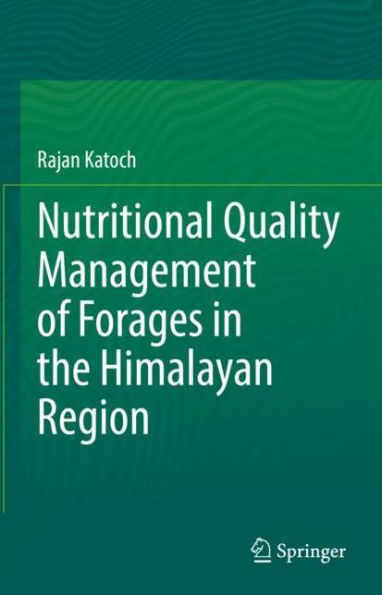• Provides a comprehensive discussion on the prospects of Himalayan forages.
• Collates findings and data based on more than two decades of research on nutritional quality of different temperate grasses, fodder trees, legumes and non-conventional forage resources.
• Includes information on different forage resources, nutritional quality of forages, niche based nutritive forage species, varietal improvement of different species for nutritionally rich forages, non-conventional forages and modern biotechnological intervention for quality improvement of forages.
• Offers a valuable resource of information on forages for researchers and policymakers
• Include information oriented toward livesk feeding, influencing their health, production and productivity affecting economic status of farmers.
• Presents exhaustive information on forage species along with pictorial presentations.
The target audience will be researchers and scientists in public and private institutions (e.g. government, academia, dairy industry), policy planners, animal nutritionists and students. The monograph is relevant for the readers interested in understanding forage quality for livesk feeding and suggest models for quality improvement of forages worldwide, in similar topographies. It is also relevant to the researchers studying forage improvement and biofortification for nutritional enhancement for improving livesk health and productivity
• Provides a comprehensive discussion on the prospects of Himalayan forages.
• Collates findings and data based on more than two decades of research on nutritional quality of different temperate grasses, fodder trees, legumes and non-conventional forage resources.
• Includes information on different forage resources, nutritional quality of forages, niche based nutritive forage species, varietal improvement of different species for nutritionally rich forages, non-conventional forages and modern biotechnological intervention for quality improvement of forages.
• Offers a valuable resource of information on forages for researchers and policymakers
• Include information oriented toward livesk feeding, influencing their health, production and productivity affecting economic status of farmers.
• Presents exhaustive information on forage species along with pictorial presentations.
The target audience will be researchers and scientists in public and private institutions (e.g. government, academia, dairy industry), policy planners, animal nutritionists and students. The monograph is relevant for the readers interested in understanding forage quality for livesk feeding and suggest models for quality improvement of forages worldwide, in similar topographies. It is also relevant to the researchers studying forage improvement and biofortification for nutritional enhancement for improving livesk health and productivity

Nutritional Quality Management of Forages in the Himalayan Region
590
Nutritional Quality Management of Forages in the Himalayan Region
590Hardcover(1st ed. 2022)

Product Details
| ISBN-13: | 9789811654367 |
|---|---|
| Publisher: | Springer Nature Singapore |
| Publication date: | 04/12/2022 |
| Edition description: | 1st ed. 2022 |
| Pages: | 590 |
| Product dimensions: | 6.10(w) x 9.25(h) x (d) |
